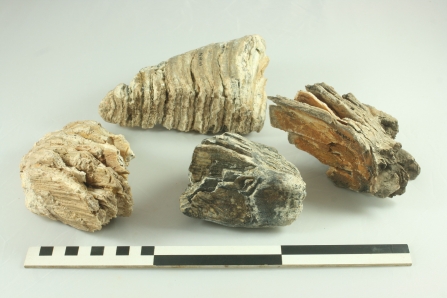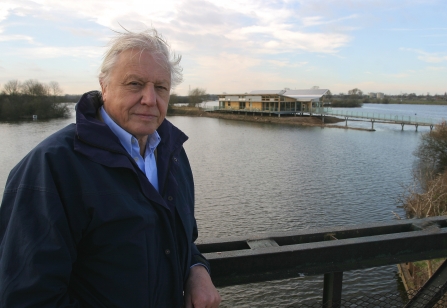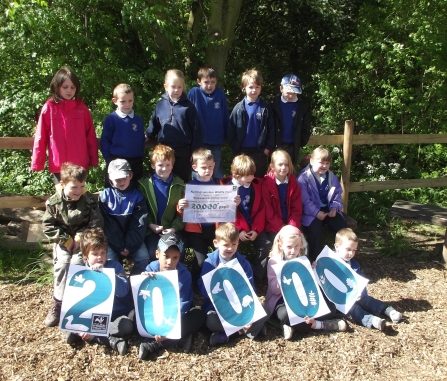Connecting people and wildlife
Attenborough nature reserve is one of the most important sites for wildlife in the UK.
Nottinghamshire Wildlife Trust fought to save Attenborough Nature Reserve back in the 1960s and have managed the site ever since.
Following the completion of sand and gravel extraction in 2017 and intensive negotiations with the owners, in 2019 we secured an opportunity to buy the reserve for £1 million. With the support of thousands of people and Biffa Award we were able to secure the future of Attenborough so we can look after its precious habitats and species for generations to come.
A History of Attenborough Nature Reserve
Attenborough Nature Reserve 10,000 years ago
Attenborough Nature Reserve represents a link in a series of nationally important biological sites across the British Isles. Whilst activities of humans have led to the creation of this habitat, it has largely re-colonised naturally and taken the place of the natural floodplain wetland resource which has been lost from much of the East Midlands.
At the end of the last ice age some 10,000 years ago, the River Trent was swollen and flooded from ice melt. The flood water subsequently deposited gravel which was carried down from the sounding hills over the valley. This was a very important event in the sites history as the following development of the site is owed to this natural history event. Prior to sand and gravel extraction, the area formed a large series of wet meadows, oxbows, wet flashes and varied deposits of organic and mineral materials. The alluvial deposits supported good grazing and hay meadows, providing habitat for a wide variety of wetland and farmland birds.
There have been a number of historic artifacts uncovered at Attenborough Nature Reserve including mammoth tusks from the Ice Age, an early medieval wooden mallet, coins and even Roman boot studs!


1086: Doomsday book
Attenborough was first mentioned in the Domesday Book as consisting of 100 acres of pasture and 4 acres of willow holt.
1919 - 1931: Willow Holt
Willows were unsuccessfully cultivated on Beeston Marsh from 1919-1931, although a local willow industry had thrived in the area up to this period. Remnants of the holt can still be seen today on Beeston Marsh and T Island, located on Beeston Pond.
1929: Gravel Extraction
From 1929, large-scale commercial extraction of the gravel commenced. Materials to and from the works were transported done by barge. Subsequently, the protruding and seasonally submerged islands which can be seen today were produced. The pattern of excavation of gravel provided habitats of different ages and stages of development. Completion of the extraction allowed the deep lagoons to regenerate naturally. Aggregate sorting and distribution is carried out at the works in Attenborough village.
1965: Application to infill submitted
In 1965 the Central Electricity Generating Board (CEGB) made an application to infill Attenborough Gravel Pits. As part of the activities from the nearby Radcliffe-on-Soar power station, it was proposed that the puvlerised fly-ash from the station could be put into the gravel pits. The gravel pits at that time had already attracted a number of interested parties and was already used by local fishermen and bird watchers. One such interested individual was Tony Kent, a university zoology lecturer. He had recognized that the site had great potential and often visited the site with some of his students. When this proposal was put forward this was indeed the start of a long battle for the ash to be taken else were.
After discussions between the CEGB, Beeston and Stapleford Urban District Council, the Trent River Board, the County Planning Department and the Wildlife Trust, the CEGB withdrew their application. Dr Tony Kent had already represented the views of the Wildlife Trust (the then Nottinghamshire Trust for Nature Conservation) and it was felt to be his case and the planning department’s acceptance of it which had cause the CEGB to take no further action following planning refusal.
1966: Attenborough Nature Reserve opened
After a lengthy process their objection was successful and the PFA consequently taken to Peterborough. The site then became the Trust’s first nature reserve. The opening was performed by the then controller of BBC2, Mr David Attenborough who was awarded honorary life membership of the Trust. It was estimated that about 500 people attended the ceremony.

Nottingham Guardian

Sir David Attenborough at 1966 opening of Attenborough Nature Reserve © Nottingham Guardian
1970: Lease expiration and agreement
Subsequently the lease expired and was replaced by an agreement in 1970 to form a Joint Management Committee with representatives of the Trust and of the new owners, RMC Aggregates Ltd, a subsidiary of Ready-Mixed Concrete (RMC), and observers from relevant official bodies. Attenborough Sailing Club lease the northern part of Coneries Pond and have planning permission to sail except during November to March.
1980s: Education centre development
Early visitors we welcomed by volunteers manning ‘The Caravan’ close to the village. The caravan acted as a rallying point for many a guided walk and workday and was the ideal place to pick up a nature trail guided walk, report a bird sighting or buy some bird food – still key functions of our modern Nature Centre.
Formal plans for an education facility were developed in the 1980s – and in 1988 Sir David Attenborough visited to view the designs. It was another 17 years before we saw these plans come to fruition.
Sir David Attenborough at Attenborough Nature Reserve in 1988 © Evening Post
2005: Attenborough Nature Centre opened
Following this, the next big event in the sites history saw the opening of the new Attenborough Nature Centre in March 2005 which marked the beginning of an exciting new chapter in the Trust’s history. This landmark facility dramatically enhanced the ability to deliver a wide range of educational activities and reach out to new audiences. The eco friendly building has won prestigious awards from the Royal Institute of British Architects (RIBA) and the Royal Institute of Chartered Surveyors (RICS) in the East Midlands. In partnership with CEMEX & NWT the Top Award for Restoration Excellence at Attenborough (Cooper Heyman Cup) was received from the Quarry Products Association.

Sir David Attenborough on bridge overlooking Attenborough Nature Centre in 2005 - Photo © Nottinghamshire Wildlife Trust
2011: 20,000th child
By 2011 we had welcomed our 20,000th child as part of formal school visits and since then thousands more school children, families and community groups have taken part in our programmes.


